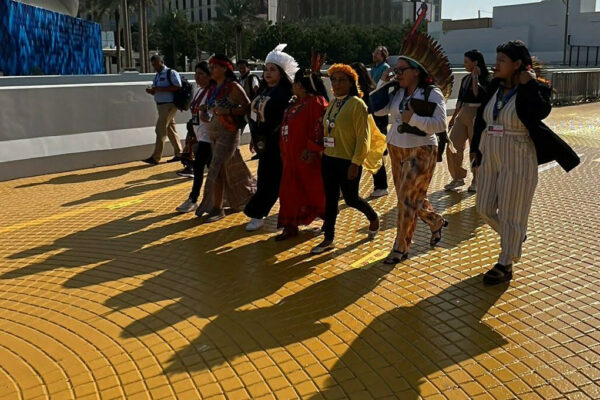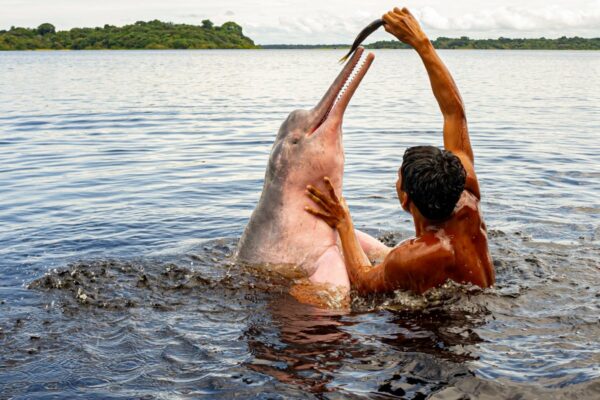Over the last few decades, the Peruvian Amazon has become a hotspot for coca cultivation. Drug traffickers in the region have shown a willingness to destroy the rainforest and kill anyone in the name of profit.
Indigenous leaders working to protect their Amazonian communities from land invasions, deforestation, and violence come into the cross-hairs, and they are forced to choose between two paths. One is to lower their profile, stop denouncing the violence, and often flee the region. Untold men and women have gone this route. The opposite path is to raise the profile of their struggle by going to the media, national authorities, and the international community, in the hope that the attention will give them a modicum of protection.
Herlín Odicio, president of the Federation of Kakataibo Indigenous Communities (FENACOKA), has opted for the latter path. In the wake of killings of various Kakataibo leaders and community members, he has spoken out in numerous interviews and even took his people’s story to the U.N. Climate Summit.
Murders of Earth defenders in the Peruvian Amazon are on the rise. According to Global Witness’ latest report about global killings of environmental defenders in 2020, Peru suffered at least six killings, a majority in the Amazon region. This includes Arbildo Melendez, president of the community of Unipacuyacu before he was shot dead on April 12, 2020. Arbildo’s confessed killer still walks free among the communities, while his widow, Zulema Guevara, receives death threats for seeking justice.
These deadly social tensions are closely related to who controls and benefits from the land. For decades, a crucial demand of Amazonian Indigenous peoples has been legal recognition of their ancestral rainforest territories. Similar to the movement by North American native peoples, they want their #LandBack.
According to a recent investigation, the opposite has been happening in Peru’s central Amazon region. Instead of responding to community requests for land titles, many dating back decades, the pertinent authorities have instead issued a tsunami of 15,000 small titles for individuals. Focusing on three Indigenous communities in the region of Huánuco, the researchers found that between 2013 and 2018, the regional authorities issued thousands of individual titles, catalyzing land invaders from other regions of Peru to steal 60,000 acres. In the community of Unipacuyacu, this means the community is essentially shut out of their own forests.
The rationale behind the individual land titling has been an “alternative development” strategy to counteract illicit drug production. These titling initiatives were financed by Peru’s National Commission for Development and Life Without Drugs (DEVIDA), which has in turn received financial support from international donors including the U.S. Agency for International Development (USAID). The results are far from reducing drug production in Peru, the titles contributed to land grabbing, deforestation, and proliferation of coca leaf production. Experts estimate that right now there are hundreds of clandestine labs and runaways operating in the area.
What’s the U.S. connection?
As a U.S.-based organization, we have always believed it is our role to hold our own government accountable for the impacts of U.S. policies in the Amazon. In 2020 we saw information on the U.S. Agency for International Development’s website claiming that, “Since 2013, USAID has provided direct government-to-government assistance to support DEVIDA’s programs in planting, land titling, and community development.” This immediately raised the question: how much funding went to DEVIDA that in turn bankrolled the land invasions in Huánuco? To date, we are still asking that question with no public response.
The CONVOCA report helps illustrate a fundamental error that is at the origin of the problem. USAID is proud to have supported and advised the implementation of DEVIDA’s alternative development strategy in the area since 2013. Since then the situation in the central Peruvian Amazon appears to have steadily deteriorated. How much damage could have been avoided if USAID and DEVIDA had consulted and listened to the constant complaints from Indigenous organizations about the irregularities of the land titling processes?
As an immediate corrective, USAID should make public all the necessary documentation on their participation as financiers and advisers of DEVIDA’s alternative development strategy, at least in the Huánuco and Ucayali regions, from 2013 to the present.
Another issue for urgent attention is the safety of today’s threatened leaders. One important step toward this goal would be financial and political support for the implementation of the recently created Human Rights Defender Protection Mechanism. Beyond USAID, the U.S. Embassy should speak out publicly in support of defenders when they are facing imminent risks.
With an eye toward addressing the underlying issues, USAID should also support the establishment of a working group composed of international organizations, DEVIDA, the relevant Peruvian Ministries, and Indigenous organizations to work on the design of a Territorial Reparation and Restitution Program.
Ultimately, a key missing ingredient has been the political will to achieve collective land titles and execution of true alternative development programs based on the life plans of the Shipibo, Yánesha, Asháninka, and Kakataibo Indigenous peoples. Much of this rests on the Peruvian authorities themselves, but the role of international development assistance must be scrutinized. We hope these goals can be achieved with the implementation of USAID’s Policy on Promoting the Rights of Indigenous Peoples and its upcoming climate policy.
The threats against Indigenous leaders like Herlin Odicio and so many others are likely to continue – and even intensify – in the near future. To match climate discourses with the actual situation in the Amazon, both national and international authorities must take meaningful steps to address both the immediate death threats and the underlying issues, particularly land tenure. Given persistent advocacy by Indigenous federations, we believe we are starting to see steps being taken in that direction. But much work remains to be done, and will likely require ongoing international solidarity campaigns as the forces working to destroy the Amazon for profit continue their advance.













